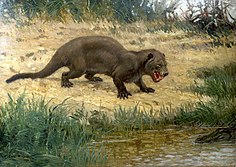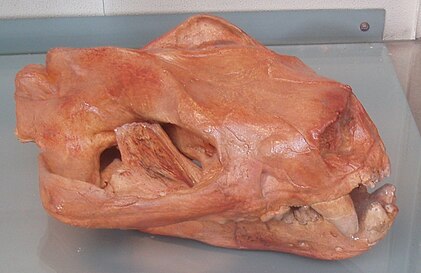Patriofelis
| Patriofelis Vremenski raspon: rani do srednji eocen
| |
|---|---|
| Naučna klasifikacija | |
| Domen: | Eukaryota |
| Carstvo: | Animalia |
| Tip: | Chordata |
| Klasa: | Mammalia |
| Red: | †Oxyaenodonta |
| Porodica: | †Oxyaenidae |
| Potporodica: | †Oxyaeninae |
| Rod: | †Patriofelis Leidy, 1870 |
| Tipska vrsta | |
| †Patriofelis ulta Leidy, 1870
| |
| Vrste | |
| |
| Sinonimi[1] | |
|
sinonimi roda: sinonimi vrste:
| |
Patriofelis (Patriofelis — „otac svih mačaka”) je izumrli rod placentalnih sisara, iz izumrle potporodice Oxyaeninae unutar izumrle porodice Oxyaenidae, koji je u periodu od ranog do srednjeg eocena nastanjivao područje Sjeverne Amerike.[11][12][13][14]
Etimologija naziva
[uredi | uredi izvor]| Rod: | Porijeklo naziva od: | Značenje naziva: |
|---|---|---|
| Patriofelis | otac svih mačaka[15] |
| Vrste: | Porijeklo naziva od: | Značenje naziva: |
|---|---|---|
| P. ferox |
|
divlji Patriofelis |
| P. ulta |
|
prosječni Patriofelis |
Opis
[uredi | uredi izvor]Vrste iz roda Patriofelis su bile veliki kopneni predatori veličine današnje pume, koji su po svojoj građi tjela nalikovale na predstavnike porodice mačke. Imale su dugi rep i kratke noge sa širokim stopalima. Stopala su im pomagala pri stabilnom hodu po mekanom i rastesitom tlu. Ove vrste su se kretale plantigradno. Lobanje ovi vrsta su bile kratke i dužine oko 25 cm. Vilice su bile kratke i snažne, sa skraćenim sjekutićima i sa velikim i masivnim očnjacima. Zubna formula kod vrsti iz ovog roda je ?.1.3.13.1.3.2.[16] Gornji karnasalni zubi su formirali oblik oštrice. Prvi par gornji i donji pretkutnjaka (P1/p1) i drugi par gornji kutnjaka (M2) nije prisutan u vilicama. Sa svojim zubima su mogle da žvaću meso i da lome kosti. Ove vrste su dostizale dužinu od 1,2 do 1,8 m (pritom ne računajući dužinu repa) i težinu od 30 do 100 kg.[13] Ukupna dužina tjela koju su ove vrste mogle da dostignu je bila oko 2,5 m, a u ramenima su ove vrte bile visoke oko 70 sm.
(autor Čarls R. Najt, 1896. god.)
(autor Čarls R. Najt, oko 1910. god.)
(autor Robert Brus Horsfol,
1913. god.)
Patriofelis ferox
Ponašanje i paleoekologija
[uredi | uredi izvor]Vrste iz roda Patriofelis su se ponašale sličano današnjem jaguaru i svoj plijen vrebale iz zasjede zaskačući ga.[17][18] Ove vrste nisu bile prilagođene brzom trčanju.[13]
Sistematika
[uredi | uredi izvor]Klasifikacija
[uredi | uredi izvor]| Vrste: | Rasprostranjenost fosila i lokacija: |
Vremenski raspon: |
|---|---|---|
| †P. ferox (Marsh, 1872)[19] | 50,5 do 46,2 mil. god. | |
| †P. ulta (Leidy, 1870)[20] | 50,5 do 46,2 mil. god. |
Filogenija
[uredi | uredi izvor]Dolje prikazan kladogram predstavlja filogenetske veze roda Patriofelis.[22][23][24]
| Pan-Carnivora |
|
†Altacreodus/Tinerhodon grupa | |||||||||||||||||||||||||||||||||||||||||||||||||||||||||||||||||||||||||||||||||||||||||||||||||||||||||
Vremenska rasprostranjenst roda Patriofelis unutar porodice Oxyaenidae
[uredi | uredi izvor]
Vidi još
[uredi | uredi izvor]Reference
[uredi | uredi izvor]- ^ J. Alroy (2002) "Synonymies and reidentifications of North American fossil mammals."
- ^ Adams, George Irving (1896) "The extinct Felidae of North America." Amer. Journ. Sci., IV. 1:419-444.
- ^ O. C. Marsh (1872) "Note on a new genus of carnivores from the Tertiary of Wyoming." The American Journal of Science and Arts, series 3 4(19-24):406
- ^ A. V. Lavrov (1999) "Adaptive Radiation of Hyaenodontinae (Creodonta, Hyaenodontidae) of Asia." in 6th Congress of the Theriological Society, Moscow, April 13–16, p. 138 [in Russian].
- ^ J. L. Wortman (1901) "Studies of Eocene Mammalia in the Marsh Collection, Peabody Museum." The American Journal of Science, series 4 12:193-206
- ^ W. D. Matthew (1899.) "A provisional classification of the fresh-water Tertiary of the West." Bulletin of the American Museum of Natural History 12:19-75
- ^ Osborn, H. F. (1892) "Taxonomy and morphology of the primates, creodonts, and ungulates." In: "Fossil mammals of the Wahsatch and Wind River beds. Collection of 1891." (H. F. Osborn and J. L. Wortman), Bull. Amer. Mus. Nat. Hist., 4: 81-147
- ^ W. D. Matthew and W. Granger (1915) "A revision of the Lower Eocene Wasatch and Wind River faunas." Bulletin of the American Museum of Natural History 34(1):1-103
- ^ W. D. Matthew (1909) "The Carnivora and Insectivora of the Bridger Basin, middle Eocene." Memoirs of the American Museum of Natural History 9:289-567
- ^ R. H. Denison (1938) "The broad-skulled Pseudocreodi." Annals of the New York Academy of Sciences 37:163-256
- ^ McKenna, Malcolm C.; Bell, Susan K. (1997). Classification of Mammals Above the Species Level. New York: Columbia University Press. ISBN 978-0-231-11012-9. Pristupljeno 16. 3. 2015.
- ^ R. K. Stucky and T. G. Hardy (2007) "A new large, hypercarnivorous oxyaenid (Mammalia, Creodonta) from the middle Eocene of the Wind River Formation, Natrona County, Wyoming." Bulletin of Carnegie Museum of Natural History 39:57-65
- ^ a b v Anne E. Kort (2019) "The Paleoecology of Patriofelis ulta and Implications for Oxyaenid Extinction", Thesis for: Master of Science
- ^ Tomiya, S.; Zack, S. P.; Spaulding, M.; Flynn, J. J. (2021). „Carnivorous mammals from the middle Eocene Washakie Formation, Wyoming, USA, and their diversity trajectory in a post-warming world”. Journal of Paleontology. 95 (Supplement S82): 1—115. doi:10.1017/jpa.2020.74.
- ^ Palmer, Theodore Sherman (1904). Index Generum Mammalium: A List of the Genera and Families of Mammals (na jeziku: engleski). U.S. Government Printing Office.
- ^ G. F. Gunnell (1998) "Creodonta". In C. M. Janis, K. M. Scott, and L. L. Jacobs (eds.), "Evolution of Tertiary Mammals of North America, Volume 1: Terrestrial Carnivores, Ungulates, and Ungulate like Mammals", Cambridge University Press, 703 pages ISBN 9780521355193
- ^ Anne E. Kort and P. David Polly (2018.) "Niche Differentiation in Eocene carnivores: Unique lumbar specializations in the oxyaenid Patriofelis" in "The Society of Vertebrate Paleontology 78th annual meeting"
- ^ Kort, A. E.; Ahrens, H.; Polly, P. D.; Morlo, M. (2022). „Postcrania and paleobiology of Patriofelis ulta (Mammalia, Oxyaenodonta) of the Bridgerian (lower-middle Eocene) of North America” (PDF). Journal of Vertebrate Paleontology. 41 (6): e2045491. doi:10.1080/02724634.2021.2045491. Arhivirano iz originala (PDF) 10. 09. 2022. g. Pristupljeno 10. 09. 2022.
- ^ O. C. Marsh (1872) "Preliminary description of new Tertiary mammals. Part II." Arhivirano na sajtu Wayback Machine (26. februar 2022) American Journal of Science 4(21):202-224
- ^ J. Leidy (1870) Untitled [Patriofelis ulta proposed during Proceedings of the March 8 meeting of the Academy of Natural Sciences], in Proceedings Proceedings of the Academy of Natural Sciences of Philadelphia, Volume 22, p. 9-11.
- ^ Robinson, P. (1966). „Fossil Mammalia of Huerfano Formation, Eocene, of Colorado”. Bulletin of the Peabody Museum of Natural History. 21: 48—49.(Plate VII)
- ^ Gunnel, Gregg F.; Gingerich, Philip D. (30. 9. 1991). „Systematics and evolution of late Paleocene and early Eocene Oxyaenidae (Mammalia, Creodonta) in the Clarks Fork Basin, Wyoming” (PDF). Contributions From the Museum of Paleontology. The University of Michigan. 28 (7): 141—180. Pristupljeno 3. 1. 2010.
- ^ Solé, F. & Ladevèze, S. (2017) "Evolution of the hypercarnivorous dentition in mammals (Metatheria, Eutheria) and its bearing on the development of tribosphenic molars." Evolution & Development, 19(2), 56–68.
- ^ Prevosti, F. J. & Forasiepi, A. M. (2018) "Introduction. Evolution of South American Mammalian Predators During the Cenozoic: Paleobiogeographic and Paleoenvironmental Contingencies", Springer Geology. Springer, Cham.
Literatura
[uredi | uredi izvor]- J. Leidy (1873) "Part I. Contributions to the extinct vertebrate fauna of the western territories." In F. V. Hayden (ed.), Report of the United States Geological Survey of the Territories 1:1-358
- E. D. Cope (1880) "On the genera of the Creodonta." Proceedings of the American Philosophical Society 19:76-82
- W. B. Scott (1892) "A revision of the North American Creodonta with notes on some genera which have been referred to that group." Proceedings of the Academy of Natural Sciences, Philadelphia 44:291-323
- J. L. Wortman (1894) "Osteology of Patriofelis, a Middle Eocene creodont." Bulletin of the American Museum of Natural History 6(5)
- J. L. Wortman (1902) "Studies of Eocene Mammalia in the Marsh Collection, Peabody Museum." The American Journal of Science, series 4 13:197-206
- O. P. Hay (1902) "Bibliography and Catalogue of the Fossil Vertebrata of North America." Bulletin of the United States Geological Survey 179:1-868
- W. D. Matthew (1910) "The phylogeny of the Felidae." Bulletin of the American Museum of Natural History 28(26):289-318
- M. R. Thorpe (1923) "Notes on the Bridger (Eocene) Carnivora." Arhivirano na sajtu Wayback Machine (9. januar 2023) American Journal of Science 5(25):23-39
- C. L. Gazin (1957) "A skull of the Bridger Middle Eocene creodont, Patriofelis ulta (Leidy.)" Smithsonian Miscellaneous Collections 134(8):1-20
- L. Van Valen (1966) "Deltatheridia, a new order of Mammals." Bulletin of the American Museum of Natural History 132(1):1-126
- L. Van Valen (1967) "New Paleocene insectivores and insectivore classification." Bulletin of the American Museum of Natural History 135(5):217-284
- C. L. Gazin (1976) "Mammalian Faunal Zones of the Bridger Middle Eocene." Smithsonian Contributions to Paleobiology 26:1-25
- Kort, A. E.; Jones, K. E. (2023). „Function of revolute zygapophyses in the lumbar vertebrae of early placental mammals”. The Anatomical Record. doi:10.1002/ar.25323.






